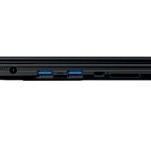Gigabyte Aero 15Y.


NVIDIA’s new GeForce RTX graphics have finally made their way to laptops, which means that some sweet, sweet performance is now going to be available on your next portable gaming system.
The new Gigabyte Aero 15Y v9 is the latest version of the company’s excellent slim-and-light gaming laptop. At first glance, it offers much of the same as its predecessor, but Gigabyte is now making a renewed push to highlight its choice of quality components. More importantly, the Aero 15Y now supports much more powerful hardware than before, which is seriously impressive considering that the laptop’s dimensions remain unchanged and it is still as sleek as ever.
While the overall design remains the same, the Aero 15Y offers small but thoughtful improvements over the original Aero 15. For example, Gigabyte has finally included a Windows Precision Touchpad on the new Aero 15Y, a long overdue change that adds a greater degree of reliability and accuracy to the built-in trackpad. Gigabyte has still stuck with a small-ish plastic trackpad though, and I’d really have liked to see a larger glass trackpad like the one on the Razer Blade.
However, what really stands out is Gigabyte’s decision to call attention to the provenance of the components it’s using. The company is using a 4K IPS panel from AU Optronics (the 1080p models use LG panels), Samsung memory, and an Intel 760p SSD. In addition, it features a Killer E2500 Gigabit Ethernet Controller and a Killer Wireless-AC 1550i network adapter, both of which can work together to enable a maximum throughput of up to 2.783Gbps, thanks to Killer DoubleShot Pro technology. The old Aero 15X relied on an Intel solution for networking, but Gigabyte has opted for a more gamingoriented solution this time around.
The switch to a Killer networking solution isn’t that huge, and some folks still tend to prefer Intel. However, I like that Gigabyte is talking about where its components come from, and I personally find it quite a confidence-inspiring move that more manufacturers should follow.
But now that manufacturers everywhere are in the middle of releasing their GeForce RTX notebooks, the Aero 15Y is up against some stiff competition. Its key selling point is probably its support for the overclockable Intel Core i9-8950HK processor, which still isn’t that common on a notebook of this size.
That aside, the display has to be one of the best parts of the laptop. The edge-to-edge bezels ensure a more immersive viewing experience, and the 4K IPS panel is a joy to look at. It is crisp and bright, and its X-Rite Pantone color calibration with a Delta-E value of less than 1 means that colors should be pretty accurate. The original Aero 15 was designed for both gamers and creators, and the same goes for the Aero 15Y as well, which also ships with Windows 10 Pro instead of Home.
One trade-off of this design is the need for a bottom-mounted webcam, which makes for some unflattering camera angles.
However, while a 4K display sounds great on paper, it’s really not that practical for a gaming system, and out tests confirm this as well. It also drives the price of the unit up considerably, and I’d take a 1080p 144Hz panel over a 4K 60Hz display any day.
Moving on, the keyboard deserves praise as well. It’s one of the best I’ve used on a Max-Q laptop, and it off ers good key travel and pleasantly tactile feedback. In addition, there is support for per-key RGB backlighting and you can customize the keyboard using the built-in Control Center software. Some of you may find the full-sized keyboard a little cramped, but I think it’s just a matter of getting used to it.
But for all the talk of small, incremental improvements, the headline feature on the Aero 15Y is probably its ability to intelligently distribute power between the CPU and GPU, depending on the task at hand. It is powered by Microsoft’s Azure AI, and it can supposedly reduce heat and noise by optimizing things like fan speeds. For example, if you just launched a game, the AI would allocate more power to the GPU, initiate Gaming mode, and ramp up fan speeds. But if you were working in a content editing app, it might instead divert more power to the CPU and reduce fan speeds.



This is a portable machine that wants to be a desktop replacement, but it does run quite hot and noisy.























